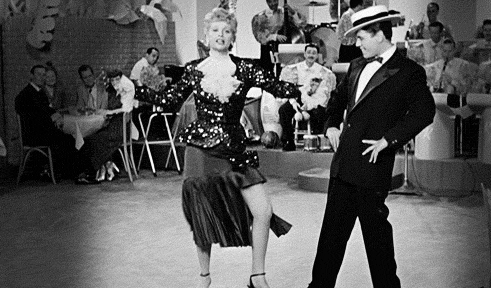I LOVE LUCY
EDUC 6165
I Love Lucy is an iconic 1950’s
television sitcom that has impressed all types of audiences for decades.
Lucille Ball is one of my most beloved actresses that I see as a great
communicator both on screen and off. According to biographies and other
literatures written about Lucille Ball she was the first successful lady in
television history to become shared CEO of Hollywood’s Desilu Productions
alongside her husband Desi Arnaz producing and acting in many of their own
films. “Desi-Lu”… get it? LOL!
The purpose of this blog is to
find what sort of communication skills and styles characters display on
television with or without sound. What better example for me than using Lucille
Ball and husband Desi Arnaz who once starred in the boundless sitcom, I Love
Lucy. This is what I have determined…
I Love Lucy’s season 1 episode 3,
“The Diet” (1951) illustrates zany Lucy (Ball) who wants to shed weight so that
she could perform in Ricky’s (Arnaz) night club finding her spot in show
business (ironic, right?). After 4 days of diet and exercise, even though she
was not nominated, Lucy managed to fit the required dress for the performance then
sneaking on stage to sing and dance to “Cuban Pete”-originally sung by Louis
Armstrong in 1937- with Ricky who was surprised it was her in the dress and it
was her as his partner.
 |
| Body movement is nonverbal |
 |
| Facial expressions are nonverbal |
 |
| Signaling is nonverbal |
The communication I find
intriguing during this particular episode is based on what authors, Dan O’Hair
and colleagues (2015) suggest as nonverbal communication. With or without
sound, I see where this is relevant. Moreover, according to Dan O’Hair and
colleagues (2015) nonverbal communication involves no words so engagements like
signaling, emotions, body movements, etc. are apparent as I watch Lucy take on
diet, exercise, and performance. Her nonverbal communication such as her body
movements display fatigue in her posture as she runs around her apartment, her
emotions in her face show determination to lose weight (either that or her
tongue hanging out as everyone eats a juicy steak in front of her. Poor Lucy is
stuck with a celery stick). And, signaling like popping gum, holding her hand
on her hip as she bobs her leg, and swirling her purse as she sings and dances
shows nonverbal communication that she is “in shape” and able to make quite a
performance proving she can fit in a required dress and can handle show
business. She proved Ricky wrong.
This episode of I Love Lucy, “The
Diet” (1951) signifies what Dan O’Hair and colleagues (2015) explore regarding
types of communication that expose various actions, relationships, and
behaviors with or without use of word –with or without sound. Lucy and Ricky’s
relationship based on their nonverbal communication skills, especially Lucy’s,
proves that content of dialogue, transitions, and yes signaling, emotions, and
body movements is what I feel made I Love Lucy one of the most watched
television sitcoms during the 1950’s and still remembered. I believe both
Lucille Ball and Desi Arnaz were able to empower successful communication on
screen and off.

An “aha” moment that would help me
and colleagues when we consider communication skills and styles is that
leadership is essential especially if we want to aspire in the field of Early
Childhood where communication skills is imperative. As Lucille Ball became a
leader of Desilu Productions and as her character Lucy was determined to make a
mark in show business, using types of communication skills, even without words
or sound, can help us grow and help us land where we want to be as educators in
Early Childhood.
Works Cited
IMDb (n.d.). I Love Lucy:
The Diet. (TV Episode 1951). Retrieved from http://imdb.com/title/tt0819061
Wikipedia (n.d.). Cuban
Pete. Retrieved from http://en.wikipedia.org/wiki/Cuban_Pete
Youtube (n.d.). I Love Lucy-
Cuban Pete and Sally Sweet. Retrieved from http://www.youtube.com/watch?v=6-hk_7Ln-MM
Cassie,
ReplyDeleteI love your blog post on I love Lucy, I wish i could of seen your feedback on a show that you have never seen before. I rarely have watched the show but I believe she is always giving quirky gestures to the things she experiences. Your post showed in great detail how her nonverbal communication tells the show.
Good point. A show I have never watched before but my sister seems to gush over is Gossip Girl. I never understood the storyline so I don’t particularly care to watch it... so I turned it on... muted. Just like what I say about I Love Lucy this show shows movement, interaction, eye contact, signaling just so communication is made present. I believe whether or not we know the characters, situations, context, or props communication is communication verbal, nonverbal -it’s just relationship in cases like this that factors toward outcome or ending.
ReplyDeleteThank you for the feedback.
Dear Cassandra,
ReplyDeletethank for your reminder through your short sentence that it is important as EC professional to communicate imperatively. The teacher is responsible to lead the children to explore the world.
Great Post !
Thank you for the feedback Diah. We have learned a lot about EC but this course tells us that communication is the foundation of learning and development and we have to honor the skills so that we can perform actively and efficiently. Communication IS IMPERATIVE. :)
ReplyDelete